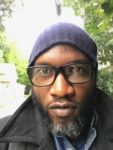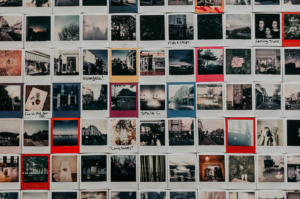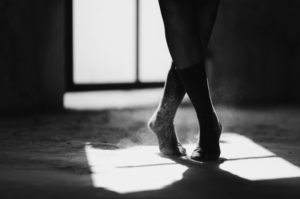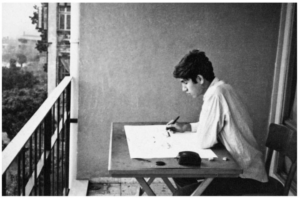
My father said it was “catastrophic”. The way the letters rolled off his tongue, the way each syllable smacked his palette, had to mean something terrible.
“Just horrible, Massa,” said his best friend, Abereck Awah, also known as Uncle Double-A. He must’ve agreed with me, I thought. Uncle Double-A was one of those adults who treated kids like adults, ever considering their perspectives. He also always brought the party when he came to visit my parents. That night while he spoke to them, my siblings and I were going through an oil-stained paper bag of soya and drinking Fanta, childhood delicacies from the bar up the road from our home in Douala. However, our minds were trying to figure out where and when this ‘catastrophe’ happened, and what it meant.
“I visited Lake Nyos when I was young,” my mother said, changing the dynamic of the conversation we were eavesdropping on. It was close to Wum, the spring of my matrilineal lineage. That my mother’s past was tied to this place of present foreboding increased my need to understand what they were talking about.
“Massa, I don’t know what I’d do if I came home and saw my entire family dead,” Uncle Double-A said. He chugged some courage from his Heineken, then added, “Some people drank bleach, others cut their veins.”
After he left, my mom told us of the catastrophe that had befallen Cameroon. The day before, on 21 August 1986, Lake Nyos had killed over 1700 people and 3500 livestock.
I had a hard time sleeping that night because I did not understand how a lake could be so deadly.
Lake Nyos is a crater lake in the Oku mountains of Cameroon’s North West province. These mountains are part of the Cameroon Volcanic Line which begins in the Atlantic and reaches northeastward into a nation that is a microcosm of Africa. According to experts, there has been volcanic activity along these mountain ranges for 80 Ma years. Incidentally, this activity was at the heart of the catastrophe my parents spoke of.
Underneath the dark blue-green surface of Lake Nyos, past the lake bed into the earth’s mantle, the movement of magma created pockets of carbon dioxide, an odious and odorless gas, which escaped to the surface via a limnic eruption. Eyewitnesses described it as a strange white mist that rose from the lake. Because ‘this mist’ (estimated to be about 300,000 to 1.6 M metric tons of carbon dioxide) was denser than air, it sunk closer to the ground, displaced most of the oxygen, and suffocated most aerobic lifeforms within a 16-mile radius of its origin. A macabre spectacle followed. Cattle fell dead while grazing, people died where they lay and sat, in their bedrooms, living rooms, and kitchens. Dogs died on watch and cats on nocturnal prowls. Insects succumbed too.
The next morning, Lake Nyos was on the news. The Francophone broadcasters spoke about the catastrophe but the Anglophone journalists cried. If the disaster had happened in Douala or Yaounde (French-speaking parts of the country) the reaction would’ve probably been different. But Cameroon has always been tearing at its seams. It was no different then. It is no different now.
Thankfully, my mother is immutable, and lovingly so. That morning she continued filling in the details.
“They said not to throw stones in it when we went there as kids,” she told us over breakfast. The morning smelt like ripe plantains, eggs, Nido milk, Ovaltine, baguettes, honey, mangoes, and watermelon. Saturday mornings were the mornings my mother gave more after she’d given everything else. She would spread, stir, dish, and stuff then send us off into the morning sun. A mound of fufu and eru always waited for us at lunch.
“Why can’t you throw stones in it?” I asked. My big sister, Kuba, rolled her eyes while my brother, N’jumbwe, glared. They called me “Mr. Why.”
“I don’t know and I wasn’t like you,” my mother chuckled, adding several golden sliced plantains on my plate. There were days when I ate fried plantains for breakfast, lunch, and dinner. Sometimes, it’s all I would eat for days. My father thought it was because I was to humans as Lake Nyos was to lakes – different.
“I know a man who was like you, son,” my father started, then paused, took a bite of food, and waited till everyone’s eyes begged him to continue. He always did that, chewing as if he wanted to savor the dance of fats and carbs and protein in his mouth, imprisoning everyone in the suspense he’d created. We were greedy for his stories.
“So, Pa Ngende once went to challenge the male lake in Muanenguba,” he continued. Like Lake Nyos, the twin lakes of the Muanenguba mountains are crater lakes, also on the Cameroon Volcanic Line, located in the South West region of the country in the land of the Bakossi people – the people my father said are mine. The female lake is most accessible and on a Bakossi-bright day, she sacrifices her tranquillity for nets, canoes, children, joyful sounds, and ripples.
“The male lake is wicked,” my father said. “You must go to a medicine-man to take you there. Even dead leaves are afraid to fall in it, and that’s why you don’t throw stuff in these types of lakes because nothing will go in.”
“Bakossi dem and their witchcraft,” my mother scoffed.
“Is prayer not a form of witchcraft?” my father asked. “The lake has our ancestors. Is Jesus not a Jewish ancestor?
They were both laughing, doing that thing that they did when they disagreed, only to agree minutes later.
“So, Pa Ngende went there and he threw the first rock and the first rock landed by his feet. He did that six times and six rocks landed by his feet. Before the seventh attempt, the stubborn man said “I am the son of the Barombi lake, the essence of water, and water must listen to me,” then threw the stone into the water.”
Lake Barombi, too, is on the Cameroon Volcanic Line. It is the largest volcanic lake in the country, close to the dusty, muddy, pulsing city of Kumba in the Southwest province.
“Then what happened?” N’jumbwe asked.
“The stone went in,” my mother said. She knew the story.
True to form, that’s when my father discovered how sweet the milk at the bottom of his coffee mug was. He slurped one sip, then another, finally declaring that condensed milk is better than Nido. I didn’t like milk. I just wanted the damn story.
“The next day, Pa Ngende woke up and he couldn’t go to the toilet,” my father resumed. “There were seven stones in his stomach. He had to go meet a medicine-man deep in the Bakossi bush, in those places where they still made E’dim. He would have died if the medicine-man didn’t treat him and take him to apologize to the lake.”
“What is E’dim? I asked. I think Kuba and N’jumbwe wanted to know too.
“E’dim is how the Bakossi waged war,” he said. “But that’s for another day.”
I didn’t know what to make of my father’s story. It sounded like it could be true, but it also sounded like Scheherazade. Why did the male lake have to be so mean anyway? Did Lake Nyos’ victims throw stones in it? Should they have apologized?
“I don’t know why these things happen,” my mother said in response to my questions. “But nature doesn’t ask ‘why’ as you do, all the time. It simply does what it does. I think nature is spectacular, unpredictable, beautiful, and violent so the world can ask, like you, ‘why?’”.
Why? It is my favorite question.
SOURCES
Krajick, Kevin.“Defusing Africa’s Killer Lakes.”Sep 2013.Smithsonianmag.com. https://www.smithsonianmag.com/science-nature/defusing-africas-killer-lakes-88765263/
“What Is Known about Volcanoes in Cameroon”volcano.oregonstate.edu. http://volcano.oregonstate.edu/what-known-about-volcanoes-cameroon
*************
Photo by Callum Parker on Unsplash










Kangsen Ekume November 07, 2021 07:59
Every sentence left me wanting to read the next. Interesting piece. Vivid depiction of the wonders of the waters of Cameroon. Beautiful and well written.